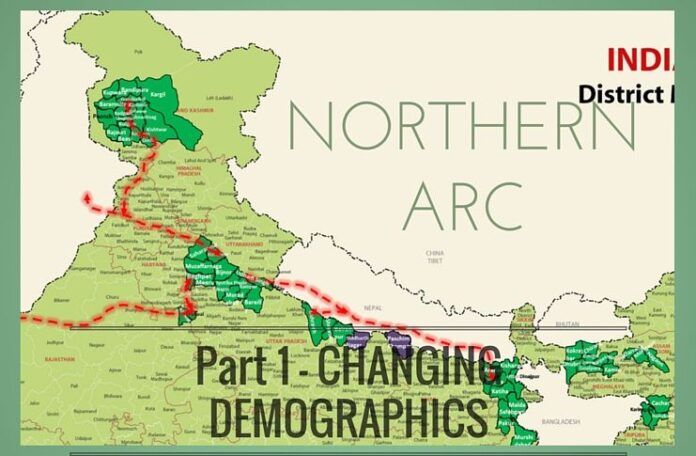
This article has been co-authored by Shanmukh (@maidros78), Aparna (@a_r_j_u_n), True Indology (@TrueIndology), Arihant (@TheMedicalActivist), Saswati Sarkar (@sarkar_swati), and Dikgaj (@dikgaj).
Introduction:
[dropcap color=”#008040″ boxed=”yes” boxed_radius=”8px” class=”” id=””]I[/dropcap]n previous articles, we have the analysed the demographic situation in Western Uttar Pradesh [8], West Bengal [9], Assam [10], Kerala and southern Tamizh Nadu [11], and Jammu and Kashmir [12]. In these articles, we showed that in the next fifty years the Hindu population stands to fall below the 50% mark (or at least close to it) in many regions of interest we considered, using various mathematical models. In this article, we will consider the other regions in the Hindi heartland where the Hindu population is shrinking sharply, due to rising Muslim population (and in place, Christian population, too, in addition to the Muslim population). In particular, we have discussed, in this article, the shrinking Hindu population in parts of Jharkhand, Bihar, Uttar Pradesh, Haryana and Rajasthan outside the Muslim belt of West Uttar Pradesh and Southern Uttarakhand which has been studied in [8]. Further, we also examine these regions and see if there is a pattern to these changes, and what the pattern portends pertaining to strategic security interests, if there is one.
For the sake of historical consistency, we have grouped the following districts together, as they existed in 1951. In this article, moving from East to West, Santhal Parganas comprises the current districts of Deogarh, Pakur, Sahebganj, Godda, Dumka and Jamtara, Purnia comprises the current districts of Purnia, Ararea, Kishanganj and Katihar, Bahraich-Gonda comprises the districts of Bahraich, Shravasti, Gonda and Balrampur, and Gurgaon comprises the districts of Gurgaon, Faridabad and Mewat.
In all our computations, we have grouped the Hindus, Jains, Sikhs, Animists and Buddhists together. In the districts under consideration, the Jains, Sikhs, and Buddhists are vanishingly small (<0.5%) in all the districts. The Animists that are present in Jharkhand are a little inconsistently recorded (sometimes as Hindu and sometimes as the local Munda religions) and the Jains were recorded as Hindu often, in the 1951 and 1961 census, in Bahraich and Gonda.
Before delving into the statistics of religious demography, we present a brief history of evolution of religious demography of the regions under consideration.
Section A: History of Abrahamization of hubs of the Hindi Belt
Section A.1: Santhal Parganas
[dropcap color=”#008040″ boxed=”yes” boxed_radius=”8px” class=”” id=””]S[/dropcap]anthal Pargana is being Christianized and Islamized as a direct consequence of Hindu mercantile greed, exploitation by Hindu landlords and Islamist quest to colonize the available land of weak tribals devoid of any political support. Ironically, the Abrahamization has been more intensive after the transfer of power in 1947 as opposed to during the British Colonial times. We provide the details below:
Santhal Paraganas are bordered by Birbhum, Murshidabad and Malda in the east, and the (old) Purnia in the north and are thus sandwiched between to Muslim heavy areas. Originally, in Santhal Parganas, the entire region, except for a small alluvial strip on the west bank of the Ganga, was inhabited by Santhals, Pahariya and other tribals [13]. They ruled the region even during the Mughal times and the Mughals, seeing little reason to engage in warfare with them, left them alone, securing the Damin-i-Koh (route from the upper Ganges valley to Bengal) via the Teliagarhi fortresses. The west bank of the Ganga was inhabited by the Bengali Zamindars, both Hindu and Muslim, all the way from Tappa Manihari to Pakaur [13]. The first clashes began between the tribals and the Zamindars in the 1780s p. 42, [13]. However, in the early-mid 1780s the EIC sent a sensitive official named Cleveland, who cut down the worst of the abuses, bribed the tribals with cloth and money, and sent missionaries to tame them pp. 44-48, [13]. However, after his early death, the fighting heated up again, when under an EIC official, Abdul Rasul Khan, known as Con Saheb, the tribals were brutally exploited. The tribals fought back ferociously and the fighting escalated with basketfuls of tribal heads being taken to the collector of Birbhum for a price p. 42, [13]. In the mid 1820s, the EIC tried reconciliation again, and tried to curb abuses, but the entry of Bengali Mahajans, Marwari and other Bihari moneylenders, and corrupt daroga officials, the exploitation of the tribals increased manifold, leading to the Santhal revolt of the 1850s pp. 51-57, [13]. When it was suppressed, the British EIC first and later the crown, decided to tame the tribals and sent in the missionaries to convert them to Christianity. Many missionary groups entered between 1859 and 1875 and the conversion was attempted pp. 63-80 [13]. However, till 1951, only about 0.17% of the district was Christian. But in the post independence era, the region has been invaded by Bihari Muslims from the north and the Bangladeshis and other Bengali Muslim groups from the east, so that both Sahebganj and Pakaur are in imminent danger of turning into Muslim majority districts in the next 50 years, and even Godda is showing a sharp fall in the number of Hindus and a corresponding rise in both Christians and Muslims. Further, since 1991, the Christian groups are also making headway and the number of Christians has grown by 3.5 times in the last 20 years between 1991 and 2011 (see graphs for Santhal Parganas district in the Constant growth section).. The rapid rise of both the Muslims and the Christians at the expense of the Hindus leaves the Hindus vulnerable in this district. The collapse of Hindus has serious security implications which we discuss subsequently.
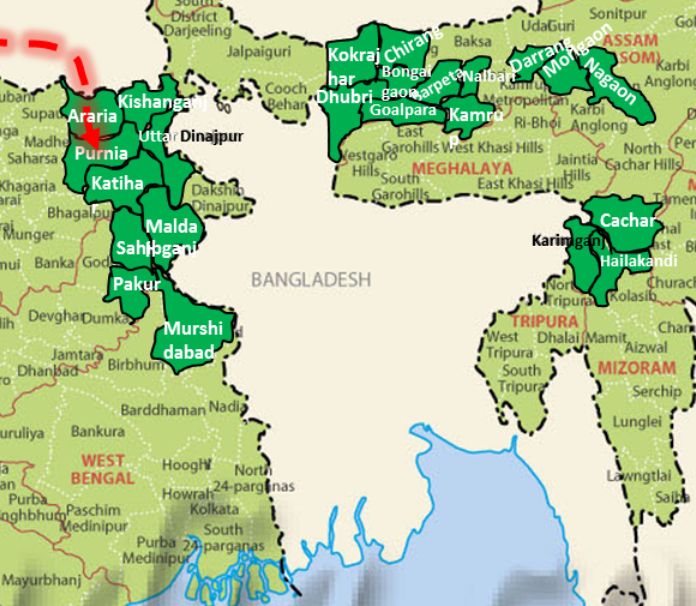
Section A.2: Purnia
[dropcap color=”#008040″ boxed=”yes” boxed_radius=”8px” class=”” id=””]T[/dropcap]he Islamization of Purnia is again a consequence of conversion by Sufis operating under the political protection of the Mughals, settlement of Muslim peasants to bolster Hindu mercantile profit and appeasement of Muslims by political parties post the transfer of power in 1947. We trace the history below.
The Purnia district, which borders Dinajpur in the east, is a natural extension of the Murshidabad-Malda belt of West Bengal. The region was never really conquered until the Mughal times and had been ruled by the Koch-Rajbongshi tribes, especially east of the Kosi. Aided by geography and the short campaigning period available for actions against them, Koch-Rajbongshi tribes put up a ferocious resistance to conquest against the Bengal Sultanate and the Mughals. However, when the Koch-Rajbongshi tribes were temporarily defeated in the 17th and 18th centuries, Sufis obtained significant conversions. The region has a high, Muslim population due to the conversion of some of the Maithili and Koch-Rajbongshi population in the area during the Mughal and Bengal Nawab times. Indeed, the Purnia District Gazetteer of 1908 observes that the Muslims presumed to descend from the Koch-Rajbongshis still follow a mixed tradition of worshipping both Hindu Gods and Goddesses such as Devata Maharaj and Bishahari-mai p.74-76. [2] . The Muslim population was augmented in the Katihar and Purnia regions by the introduction of a large number of Bihari and Bengali Muslim peasants in the 1800s to grow indigo in the newly claimed regions. p. 138, [2]
The region (along with Malda and Dinajpur) witnessed the migration of Muslim peasants to East Pakistan (currently Bangladesh) during Partition, but many of them returned in the wake of the Nehru-Liaqat agreement which was essentially intended to protect the Muslim returnees. Many of these Muslims peasants who had left for East Pakistan had supported the Partition. They spoke Urdu and had assumed that West Pakistan’s Urdu dominance would apply in the erstwhile East Pakistan as well. However, the Urdu-advocating Muslims were received with animosity in East Pakistan, which intended to maintain a Muslim religious and Bengali linguistic identity [23]. Cross-border migration had attendant atrocities as well. The Nehru-Liaqat Pact was signed on 8th April 1950 to “protect religious minorities, provide a safe passage to them’’, and to ensure that “looted properties would be returned and forced religious conversions would be de-recognized” [24]. It is evident from the sharp rise of Muslim population in the region between 1951-1961, as shown by Census numbers, that under the cover of “safe passage intended for the religious minorities”, the Urdu-advocating Muslims returned. Specifically, the (then) united Purnia district (along with the united Dinajpur and Malda) districts witnessed a sharp rise in Muslim population between 1951 and 1961 [21]. To estimate the number of Muslims who returned to Malda and Dinajpur in the wake of the Nehru-Liaqat Pact, we estimated the number of expected Muslims in Malda and Dinajpur using the growth West Bengal Muslim growth rate for the 1951-1961 decade and subtracted this expected number from the actual number of Muslims present in these districts in 1961 as reported by Census. We similarly estimated the expected number of Muslims in Santhal Parganas and Purnia using the Muslim growth rate in Bihar for 1951-1961 decade. This estimate shows that approximately 250,000 Muslims returned to Purnia, and 75,000 to Santhal Parganas, 150,000 Muslims returned to Dinajpur in West Bengal and about 90,000 to Malda. Nationwide, it was estimated that a total of nearly 1 million Muslims returned to India in the wake of the Nehru-Liaqat Pact [21].
Environment conducive to the reciprocal return of Hindus to Pakistan, East or West, and current Pakistan and Bangladesh have not however been created, as a result, the Hindu population of East Pakistan which is currently Bangladesh, have witnessed a sharp and steady decrease over the years, and the minuscule percentage of Hindus registered in Pakistan post 1947 has not increased either.
Section A.3: Bahraich-Gonda
[dropcap color=”#008040″ boxed=”yes” boxed_radius=”8px” class=”” id=””]T[/dropcap]he Islamization of Bahraich-Gonda was a consequence of Muslim conquest that enabled colonization of land by aristocratic Pathan and Arabic settlers who converted the Hindu peasants through a combination of economic incentives and compulsion (eg, by denying them the liberty to practice their religion). Tragically, the resistance of Hindu peasants to the Muslim invaders were curbed by Hindu princely allies (from other parts of India) of these invaders. The historical details follow.
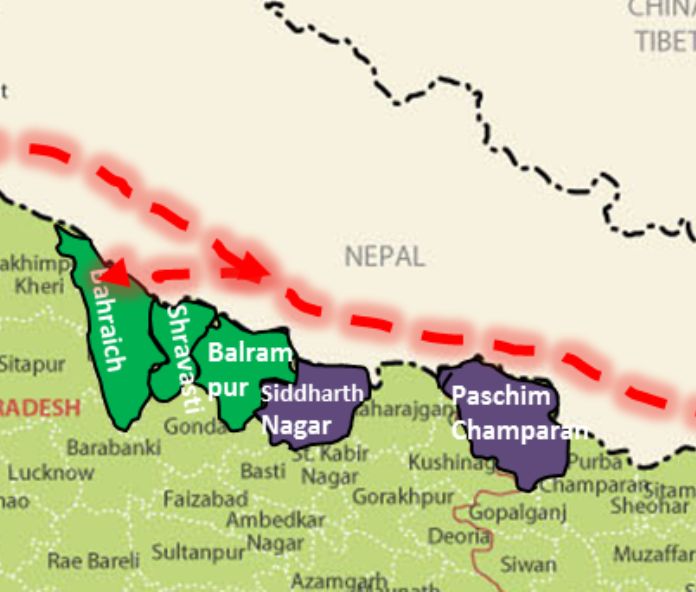
Old Bahraich and old Gonda are two districts on the Nepal border of Awadh. To the north, they are bounded by Nepal, to the east, by (old) Basti, to the south by Barabanki and Faizabad, to the south west by Sitapur and to the west by Kheri. The region around Bahraich had a thick forest cover; even today, Bahraich district has a forest cover of 14.64 %. [5]. Yet, the forest covered was cleared early and settled by Indic tribes. In fact, Bahraich denotes the easternmost extent of Painted Grey Ware PGW culture (c.1000 BCE) p.15, [6]. Subsequently, the city of Sravasti in Bahraich became deeply associated with Hindu, Jain and Buddhist traditions. However, Sravasti seems to have been the only urban centre around the site. It housed considerable number of sannyasis who eventually trekked into the highland forests (yoga). The site was abandoned by 700 CE. The region continued came to be contested between Kannauj and Gauda.
Eventually, at the advent of Islam, Bahraich was ruled by Kalachuri rulers Gangeyadeva and his son Karna. Bahraich first came into Muslim hands during the campaign of Bakhtiyar Khilji (c.1206) [7]. However, only the town seems to have come into their hands and the forest zone seemed to have still been independent. Every now and then, the forest chieftains descended on the town and plundered it. Thus we hear that prince Nasiruddin Mahmud(c.1230), son of Iltutmish, “overthrew and sent to hell the accursed Bartuh under whose hands and sword more than one hundred and twenty thousand Musulmans had received martyrdom” [7]. Sultan Nasiruddin Mahmud fought “in that country and in the hills many battles against the infidels” [7]. It was Balban who seems to have finally subjugated these infidel tribes of Bahraich for we hear that under him “ decrees of fate the fortune of the Turks now triumphed, and the power of the Hindus was levelled with the dust” [7]. The early chroniclers (Utbi,Juznani, Minhaj) are completely silent about Salar Ghazi and his tomb at Bahraich. The first reference to Salar Ghazi’s tomb comes from Ibn Babtuta. In the year 1340 Muhammad bin Tughluq performed a pilgrimage to Bahraich, accompanied by Ibn Battuta, who described not only the legends connected with the saint, but even some of the details of his cult, and in particular, the ritual of the veneration of the saint’s banner and spear. Sikandar Lodhi forbade this practice and also banned women from entering the saint’s tomb. It is seems fairly clear that Salar Masud’s tomb became a popular place of pilgrimage for Muslims by 1350. In Ain-i-Akbari, it is mentioned as a land which housed rebels.
Further, Bahraich was considered a banjar (uncultivable) land . It was starting from the Mughal days well into the days of Nawabs that there had been a constant migration of Pathan tribes to this country. The Pathans of early mughal days were rebels who fled east further from the centre of Mughal power. During the days of Awadh Nawab, many Pathans were enlisted as mercenaries in the army. As a result, pathans formed 36% of Ashraf castes who in turn formed 33 % of Muslim population of Oudh (1891 census) However, Bahraich would no more be a banjar land in the future. The process had already begun. It was in the 14th century that the earliest Sayyid families migrated to Bahraich. The Sayyids as supposed descendants of Prophet Muhammad were highly esteemed in Muslim world. One of the Muslim houses asserted their descent from Sayyid Taj, said to have emigrated from Arabia in the mid-fourteenth century. Another one traced itself back to Sayyid Ahmad, also from Arabia. Most of these Sayyid families were invited and granted settlements by the Muslim rulers to maintain their own legitimacy. The Mughal monarchs often granted revenue from land to religious scholars, mystics, and Sayyid or other noble families. These land grants subsequently led to an increase in the demand of land. Sayyids and other Muslim Shaikhs became the de-facto zamindars. For example, In Bara Banki, Muslim Shaykhs and Sayyids owned almost half the villages, though they constituted only 2.6 and 0.6 percent of the district’s population, respectively, in the late nineteenth century. Deforestation, agricultural expansion and religious persecution followed. The Sayyid landowners sought peasantry among the locals and didn’t let them build their temples. Thus began the process of Islamization of natives.
In Gonda district, the early dynasties of Doms seem to have been extinguished by Sultanate under a Rajput adventurer from Gujarat named Sahaj Singh and his Pathan troops/allies. The Rajput adventurer established the Kalhan house that ruled the region till the mid 1500s. However, the Kalhan house was destroyed in a massive flood p. 87, [15] and the new rulers (Bisens and Kakar Pathans) were established in the region. However, large tracts of the districts were forested and the swamps malarial, so the population was low. Under Akbar, the region was given to Pathan Zamindars, who were to provide 1500 foot and 50 horse p. 143, [15]. In 1773, the Gonda estate was taken over by the crown of Awadh and Bahu Begum’s eunuch brought in a large number of settlers to clear the forests and cultivate the lands. p. 155, [15]
The depredations on Hindus increased under Khwaja Ainuddin in the last years of the 18th century in both Bahraich and Gonda p. 149, [15]. However, in the 19th century, many swamps were cleared, and land reclaimed, and this brought in a large number of richer Muslim landowners (both under the Nawabs of Avadh and the British), which considerably enhanced the Muslim population in both Bahraich and Gonda [15]. The Muslim population of Bahraich jumped from 12.7% in 1869 to 18.4% in 1901 p. 65, [16], due to the arrival of the new cultivators. It has been observed that it is in Bahraich and Gonda that Muslim cultivators abound p. 72, [16], whereas in other parts of Awadh, they are either zamindars or engaged in other trades, but not often actual cultivators. Nevertheless, the long and direct Pathan rule of Utraula and parts of Tulsipur (via Pathan Zamindars) is one of the major reasons for a higher Muslim population of the Gonda district, while the Pathan and Sayyid estates of Nanpara and Ambhapur have contributed significantly to the Muslim population in Bahraich. The Pathan and Sayyid estates often converted their cultivators.
Section A.4: Gurgaon
[dropcap color=”#008040″ boxed=”yes” boxed_radius=”8px” class=”” id=””]T[/dropcap]he Islamization of Gurgaon is a consequence of forced conversions during Islamic conquest, rejection of a nominally Muslim clan by other Hindu castes and radicalization by fundamentalist Muslim organizations.
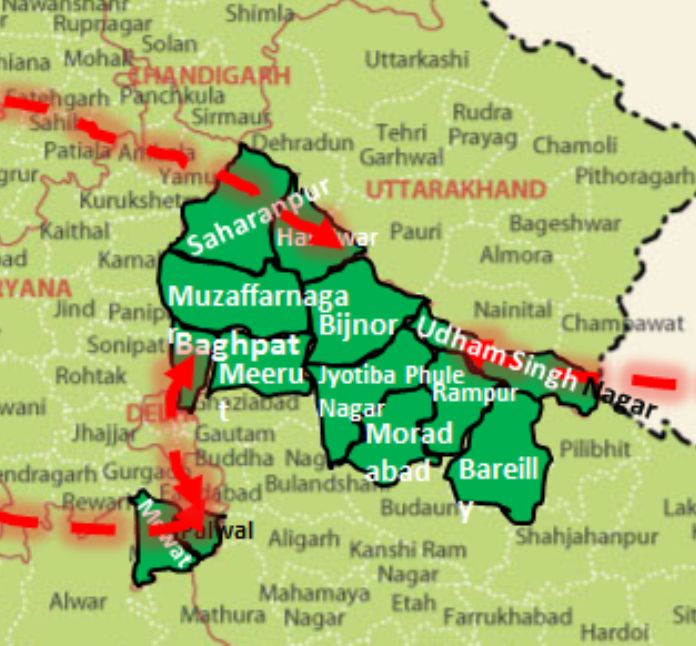
The bulk of the Muslims of Gurgaon are Meo Muslims who live in the southwest of the region, which is called Mewat. The Meos were originally a branch of the Chauhans at the north eastern corner of the Aravallis, stretching across south western (British) Gurgaon and the (then) princely states of Alwar and Bharatpur. The Meo Muslims were Muslims nominally, till the 1880s, when the Anjuman tried to radicalise them [17], [18]. However, their efforts didn’t bear much fruit and till the 1920s, they remained mostly indifferent to Islamic preachers. Then the Arya Samaj and the Tabligh entered the scene, with the former trying to turn them into Hindus and the latter make them observant Wahhabi Muslims [17]. There was too much Hindu resistance from other castes that didn’t want them back and consequently, the Tablighis won out. Further, in 1932, there began a peasant revolt, that took on a very Islamic character, and the Meos turned more radical [17]. And in 1946, incited by Maulana Abdul Kaddus – a man associated with the Muslim League – the Meos refused to pay taxes in Alwar and Bharatpur, and when it appeared that Punjab and Bengal would be given in their entirety to Pakistan, began to agitate for Meostan, that would merge with Pakistan pp. 322-323, [19]. The riots began in both Gurgaon and the Princely states of Alwar and Bharatpur, in which, a combination of Hindu castes chased out the Meos from all over the region and about forty to forty five thousand were forcibly converted to Hinduism p. 333, [19]. However, some Meos were returned to their homes from Pakistan by the efforts of Vinoba Bhave, and with the Hindu reluctance to accept them as Hindus, their own desire to have a unified community (which would be impossible if some were Hindus and others Muslims) and the Tablighi influence, the entire community turned to hardcore Islam in the subsequent decades. Now, the entire region is an Islamic stronghold and has a fast rising crime graph too [20].
To be continued…
References
[1] Sankar Ghosh, “Jawaharlal Nehru: A Biography”,
[2] LSS O’Malley, “Purnea District Gazetteer”, 1908
[3] CZ Guilmoto and I. Rajan, “Fertility at District Levels in India: Lessons from the 2011 census”, http://www.ceped.org/IMG/pdf/ceped_wp30.pdf
[4] “Church Happy as Conversion Bill Threatens State Government”, http://www.ucanews.com/story-archive/?post_name=/2006/08/30/church-happy-as-conversion-bill-threatens-jharkhand-states-coalition-government&post_id=27867
[5] National Geographic Journal of India 16.112
[6] K. K. Sinha, Excavation at sravasti, 1967
[7] Minhaj -US -Siraj, “Tabakat i nasiri, Trans. History of India as told by its own historians volume 2”)
[8] Shanmukh, Dikgaj and Saswati Sarkar, “Western Uttar Pradesh and Southern Uttarakhand: Muslim Majority by 2061?” http://www.dailyo.in/politics/population-muslims-muzaffarnagar-uttarakhand-shamli-western-uttar-pradesh-hindus-sikh-demography/story/1/10631.html
[9] Shanmukh, Dikgaj and Saswati Sarkar, “A Demographic Warning for West Bengal”, https://www.myind.net/demographic-warning-west-bengal
[10] Shanmukh, Saswati Sarkar, Dikgaj and Aparna, “Will Assam be Muslim Majority in the next 40 years?” http://indiafacts.org/will-assam-muslim-majority-next-40-years/
[11] Shanmukh, Saswati Sarkar, Dikgaj, and Aparna, “Kerala and South Tamil Nadu – A Case of Hindu Fade out” http://indiafacts.org/kerala-south-tamil-nadu-case-hindu-fade/
[12] Shanmukh, Vikram, Aparna, Saswati Sarkar, and Dikgaj, “The Demographic expansion of Kashmir and the shrinking of Jammu and Ladakh” https://www.myind.net/demographic-expansion-kashmir-and-shrinking-jammu-and-ladakh#.V3UOVSF0xwc.twitter
[13] LSL O’Malley, “District Gazetteer of Santal Parganas”, 1910
[14] Sean Winchell, “Pakistan’s ISI: The Invisible Government”, International Journal of Intelligence and CounterIntelligence, Vol. 16(3), http://www.tandfonline.com/doi/abs/10.1080/713830449
[15] HR Neville, “District Gazetteer of Gonda”, 1905
[16] HR Neville, “District Gazetteer of Bahraich”, 1903
[17] Shail Mayaram, “Perspectives on Violence and Othering in India”
[18] Gurgaon District Gazetteer, 1883.
[19] NB Khare, “My Autobiography, or my Political Memoirs”
[20] Gangs of Mewat http://www.hindustantimes.com/india/in-mewat-govt-s-indifference-and-neglect-a-bigger-reality-than-crime/story-FaXR9hW7KNlqvSRpn0iAUL.html
[21] Partha Ghosh, “Migrants, Refugees and the Stateless”
[22] Lord Rowlatt Committee, “Seditions Committee Report”
[23] Kazi Fahmida Farzana, “The Neglected Stateless Bihari community in Bangladesh : victims of political and diplomatic onslaught” Journal of Humanities and Social Sciences, Vol 2,Issue 1, 2008
[24] Encyclopaedia Britannica “Nehru-Liaqat Pact or Delhi Pact”, 1950
[25] Joya Chatterjee, “The Spoils of Partition”
[26] Braja Bihari Kumara, “Illegal Migration from Bangladesh”
- How we computed Hindu, Muslim & Christian growth – Part 3 of Hotspots series - July 30, 2016
- Hindu population shrinking – Part 2 of Hotspots series - July 29, 2016
- Hotspots in the Hindi Belt, Part 1 – the Northern Arc - July 26, 2016

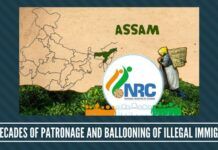

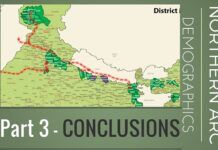







Makes depressing reading.Request authors who seem to be of high intellectual caliber to suggest ways and means of countering the demographic invasion and revival of Hindu numbers.
We are discussing forcible conversions of the past, but our media and we too turn a blind eye to forcible conversion of 800 valmiki families in Ramnagar under hold of buffalo azam khan. BJP protested and so too some Hindu orgs. But once the dust settled down, their conversion done.
From Kairana, dhindsi, Chandeli, Aligarh numerous Hindu families are forced to flee by Muslims. Over 600 families from Kairana etc.. In all these incidents, as Hindus behave like individuals and never unite to fight such persecution. Why not 800 Valmiki families, since 1 caste, could have fought tooth n nail. Fact is Hindus are darpoks, easily succumb and extreme selfish. We live for self, family, money by any means. Sad
We, as the Hindus, must ask ourselves as to what kind of country we leave behind for our children, and whether we have a duty to leave them a safe and secure country. If yes, what are we – that includes each one of us – doing to ensure it. Can we face our kids honestly on it? Or are we going to hide like cowards? Every choice we make, or fail to make, has a consequence.
The whole exercise on demographic changes, faster rise of Muslim population, Abrahamizatation is like crying over spilled milk.India succumbed to British machinations and Nehruvian ambitions right at the time of freedom and partition.Even at the time of adopting the constitution we were manipulated into accepting secularism, right to propagate(convert,) Hindus, special rights in education(al institutions), etc to the detriment of Hindu interests in addition to refusing population exchange and not occupying whole of J&K as a matter of fact
Even now at this late stage the problems of denuding Hindu population and aggressive Abbrahamization (conversions) and its fall outs can be countered effectively by reversing the un-natural partition and allowing all citizens of erstwhile AKHAND BHARAT to live as equals with common civil and criminal laws under a federal system.This step requires lots of guts and statesmanship on the part of India to convince our neighbors and withstand inimical international pressures.
There is no point blaming Nehru or anybody else. Muslim population will continue to rise and may be at later future dominate Hindus. This will not happen because of policy failures or political reasons. But because of lethargy of Hindus to reproduce.